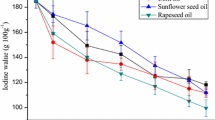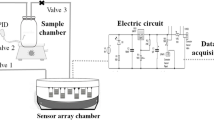Abstract
An electronic nose (zNose™) was applied to the detection of adulteration of virgin coconut oil. The system, which is based on a surface acoustic wave sensor was used to generate a pattern of volatile compounds present in the samples. Virgin coconut oil was mixed with refined, bleached and deodorized palm kernel olein at a level of adulteration from 1 to 20% (wt/wt). Adulterant peaks were identified from the chromatogram profile and fitted to a curve using linear regression. The best relationship (R 2 = 0.91) was obtained between the peak tentatively identified as methyl dodecanoate and the percentage of palm kernel olein added. Pearson’s correlation coefficients (r) of 0.92 and 0.89 were obtained between adulterant peak methyl dodecanoate and of the iodine and peroxide values, respectively. Principal component analysis (PCA) was used to differentiate between pure and adulterated samples. The PCA provided good differentiation of samples with 74% of the variation accounted for by PC 1 and 17% accounted for by PC 2. Pure samples formed a separate cluster from all of the adulterated samples.





Similar content being viewed by others
References
Che Man YB, Marina AM (2006) Medium chain triacylglycerol. In: Shahidi F (ed) Nutraceutical and specialty lipids and their co-products. Taylor & Francis, Boca Raton, pp 27–56
Nevin KG, Rajamohan T (2004) Beneficial effects of virgin coconut oil on lipid parameters and in vivo LDL oxidation. Clin Biochem 37:830–835
Nevin KG, Rajamohan T (2006) Virgin coconut oil supplemented diet increases the antioxidant status in rats. Food Chem 99:260–266
Nevin KG, Rajamohan T (2008) Influence of virgin coconut oil on blood coagulation factors, lipid levels and LDL oxidation in cholesterol fed Sprague–Dawley rats. Eur J Clin Nutr Metab 3:1–8
Marina AM, Che Man YB, Nazimah SAH, Amin I (2007) Analysis of adulteration of virgin coconut oil by palm kernel olein using Fourier transform infrared spectroscopy. J Food Lipids 14:111–121
Marina AM, Che Man YB, Nazimah SAH, Amin I (2009) Monitoring adulteration of virgin coconut oil by selected vegetable oils using differential scanning calorimetry. J Food Lipids 16:50–61
Yu H, Wang J, Yao C, Zhang H, Yu Y (2007) Quality grade identification of green tea using E-nose by CA and ANN. LWT Food Sci Technol 41:1268–1273
Drake MA, Gerard PD, Kleinhenz JP, Harper JP (2003) Application of an electronic nose to correlate with descriptive sensory analysis of aged Cheddar cheese. LWT Food Sci Technol 36:13–20
Santos JP, Fernandez MJ, Fontecha JL, Lozano J, Aleixandre M, Garcia M, Gutierrez J, Horrillo MC (2005) SAW sensor array for wine discrimination. Sens Actuators B 107:291–295
Lammertyn J, Veraverbeke EA, Irudayaraj J (2004) zNose™ technology for the classification of honey based on rapid aroma profiling. Sens Actuators B 98:54–62
Shaw PE, Rouseff RL, Goodner KL, Bazemore R, Nordby HE, Widmer WW (2000) Comparison of headspace GC and electronic sensor techniques for classification processed orange juices. LWT Food Sci Technol 33:331–334
Zhang H, Chang M, Wang J, Ye S (2008) Evaluation of peach quality indices using an electronic nose by MLR, QPST and BP network. Sens Actuators B 134:332–338
Zhang H, Wang J, Ye S (2008) Prediction of soluble solids contents, firmness and pH of pear by signals of electronic nose sensors. Anal Chim Acta 606:112–118
Gomez AH, Hu G, Wang J, Pereira AG (2006) Evaluation of tomato maturity by electronic nose. Comput Electron Agric 54:44–52
Gan HL, Tan CP, Che Man YB, NorAini I, Nazimah SAH (2005) Monitoring the storage stability of RBD palm olein using the electronic nose. Food Chem 89:271–282
Martin YG, Oliveros MCC, Pavon JLP, Pinto CG, Cordero BM (2001) Electronic nose based on metal oxide semiconductor sensors and pattern recognition techniques: characterization of vegetable oils. Anal Chim Acta 449:69–80
Biswas S, Heindselmen K, Wohltjen H, Staff C (2004) Differentiation of vegetable oils and determination of sunflower oil oxidation using a surface acoustic wave sensing device. Food Chem 15:19–26
Shen S, Moizuddin S, Wilson L, Duvick S, White P, Pollak L (1999) Relationship of electronic nose analyses and sensory evaluation of vegetable oils during storage. J Am Oil Chem Soc 78:937–940
Carrapiso AI, Ventanas J, Jurado A, Garcia C (2001) An electronic nose to classify Iberian pig fats with different fatty acid composition. J Am Chem Soc 78:415–418
Cosio MS, Ballabio D, Benedetti S, Gigliotti C (2007) Evaluation of different storage conditions of extra virgin olive oils with an innovative recognition tool built by means of electronic nose and electronic tongue. Food Chem 101:485–491
Gan HL, Che Man YB, Tan CP, NorAini I, Nazimah SAH (2005) Characterization of vegetable oils by surface acoustic wave sensing electronic nose. Food Chem 89:507–518
Shen N, Duvick S, White S, Pollak L (2001) Oxidative stability and aromascan analyses of corn oils with altered fatty acid content. J Am Chem Soc 76:1425–1429
Mildner-Szkudlarz S, Jelen HH (2008) The potential of different techniques for volatile compounds analysis coupled with PCA for the detection of the adulteration of olive oil with hazelnut oil. Food Chem 110:751–761
Hai Z, Wang J (2006) Electronic nose and data analysis for detection of maize oil adulteration in sesame oil. Sens Actuators B 119:449–455
Che Man YB, Gan HL, NorAini I, Nazimah SAH, Tan CP (2005) Detection of lard adulteration in RBD palm olein using an electronic nose. Food Chem 90:829–835
Cocks LV, Van Rede C (1966) Laboratory handbook for oil and fats analysis. Academic Press, London
Official Methods and Recommended Practice of the American Oil Chemists’ Society (1996) Methods Cd 1d-92 and Cd 8-53, vol 5. AOCS Press, Champaign
Pai JS, Lomanno SS, Nawar WW (1979) Effect of heat treatments on the volatile composition of coconut oil. J Am Chem Soc 56:494–497
Jayalekshmy A, Narayanan CS, Matthew AG (1991) Identification of volatile flavour compounds in roasted coconut. J Am Chem Soc 68:873–880
Jayalekshmy A, Narayanan CS, Matther AG (1987) Volatile aroma compounds of raw and roasted palm kernel. J Sci Food Agric 39:35–45
Saittagaroon S, Kawakishi S, Namiki M (1984) Aroma constituents of roasted coconut. Agric Biol Chem 9:2301–2307
Author information
Authors and Affiliations
Corresponding author
About this article
Cite this article
Marina, A.M., Che Man, Y.B. & Amin, I. Use of the SAW Sensor Electronic Nose for Detecting the Adulteration of Virgin Coconut Oil with RBD Palm Kernel Olein. J Am Oil Chem Soc 87, 263–270 (2010). https://doi.org/10.1007/s11746-009-1492-2
Received:
Revised:
Accepted:
Published:
Issue Date:
DOI: https://doi.org/10.1007/s11746-009-1492-2




